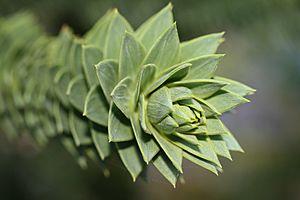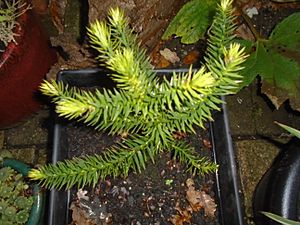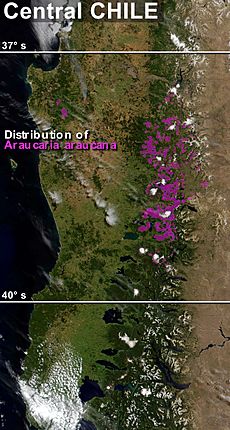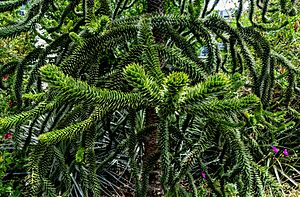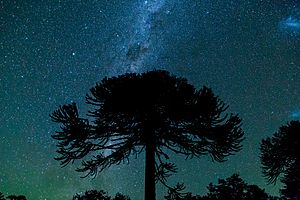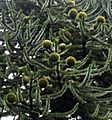Monkey puzzle tree facts for kids
Quick facts for kids Monkey puzzle tree |
|
|---|---|
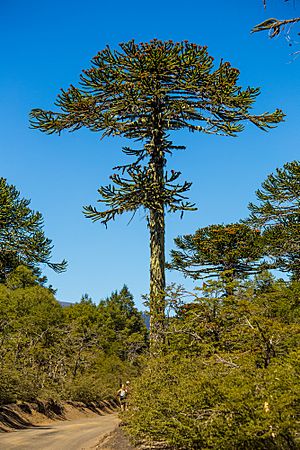 |
|
| Conservation status | |
| Scientific classification |
The Monkey Puzzle Tree (also known as Araucaria araucana, piñonero, or pewen) is a very special evergreen tree. It can grow super tall, reaching 30–40 meters (about 100–130 feet) high. Its trunk can also become quite wide, about 1 to 1.5 meters (3–5 feet) across.
This amazing tree comes from the mountains of central and southern Chile and western Argentina. It's the toughest type of tree in its family, called Araucaria. People sometimes call it a "living fossil" because trees like it have been around since prehistoric times! The Monkey Puzzle Tree is also the official national tree of Chile.
Sadly, the Monkey Puzzle Tree is now an Endangered tree. Its numbers have gone down because of logging, forest fires, and animals eating young trees.
Contents
What Does the Monkey Puzzle Tree Look Like?
The leaves of the Monkey Puzzle Tree are very unique. They are thick, tough, and shaped like scales. Each leaf is about 3–4 centimeters (1.2–1.6 inches) long. They are also 1–3 centimeters (0.4–1.2 inches) wide at the bottom and have sharp edges and tips. These leaves can stay on the tree for a very long time, sometimes up to 24 years! This means most of the tree is covered in leaves, except for the oldest branches.
Most Monkey Puzzle Trees are either male or female. This means the male and female cones grow on separate trees. However, sometimes a single tree might have both types of cones. Male cones are shaped like oblong cucumbers. They start about 4 centimeters (1.6 inches) long. When they release pollen, they grow to 8–12 centimeters (3–5 inches) long and 5–6 centimeters (2–2.4 inches) wide. The wind carries the pollen from male to female trees.
Female cones are round and large. They are about 12–20 centimeters (5–8 inches) across. These cones hold around 200 seeds. They take about 18 months to ripen after pollination. When they are ready, the cones break apart. This releases the nut-like seeds, which are 3–4 centimeters (1.2–1.6 inches) long.
The tree's very thick bark might help it survive wildfires.
Where Do These Trees Grow?
The Monkey Puzzle Tree naturally grows on the lower slopes of the Andes mountains. You can find them in south-central Chile and Argentina. They usually grow above 1,000 meters (about 3,300 feet) in elevation.
Young trees look like a pyramid or a cone. As they get older, they grow into a special umbrella shape. This is how you can easily spot a mature Monkey Puzzle Tree. These trees prefer soil that drains well and is a little bit acidic. They especially like volcanic soil. However, they can grow in almost any soil type, as long as it doesn't hold too much water.
How Do Monkey Puzzle Seeds Spread?
The Monkey Puzzle Tree produces many seeds at once, which is called "masting." Small animals, especially rodents, are important for spreading these seeds. The long-haired grass mouse, called Abrothrix longipilis, is one of the most important animals for spreading Monkey Puzzle seeds. This mouse buries the whole seeds. This helps the seeds to sprout and grow into new trees. Other animals might eat the seeds instead of burying them.
What Dangers Do They Face?
For a long time, cutting down these trees (logging) was a big problem. Luckily, logging was finally banned in 1990. However, other dangers still threaten the Monkey Puzzle Tree.
Huge fires have burned thousands of acres of Monkey Puzzle forests. This happened in 2001–2002, and even parts of national parks have burned. Some of these fires destroyed trees that were over 1,300 years old!
Another problem is too many animals eating the young trees (overgrazing). Also, invasive trees that don't belong in the area can cause problems. People also collect a lot of the piñones (the tree's seeds). If too many seeds are collected, it can stop new trees from growing.
Good news is that a project called the Global Trees Campaign planted 2,000 trees. After 10 years, 90% of those trees were still alive! This shows that we can help these trees survive.
Growing and Using the Monkey Puzzle Tree
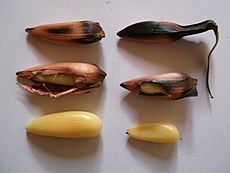
The Monkey Puzzle Tree is a popular tree for gardens. People love its unique look, with thick branches that look almost "reptilian" and a very neat, symmetrical shape. It grows best in places with mild weather and lots of rain. It can handle cold temperatures down to about -20 degrees Celsius (-4 degrees Fahrenheit).
It's the toughest tree in its family. You can find it growing well in places like western and central Europe, the west coast of North America, and in New Zealand and southeastern Australia. It can even handle salty air near the coast. However, it doesn't do well with air pollution.
The piñones, or seeds, of the Monkey Puzzle Tree are edible. They are like big pine nuts. Indigenous people in Argentina and Chile have harvested and eaten these seeds for a very long time. This tree could become an important food crop in other areas in the future. It grows well in places with cool, ocean-influenced summers, like western Scotland, where other nut crops don't grow as well.
A small group of six female trees and one male tree for pollination could produce thousands of seeds each year. Since the cones fall off the tree when they are ripe, harvesting the seeds is easy. However, the tree doesn't start producing seeds until it's about 30 to 40 years old. This can make people hesitate to plant large orchards. But once they start producing, they can live for over 1,000 years and give huge amounts of seeds!
Wild animals like rodents and wild pigs also eat the seeds. This can reduce how many seeds are available for people and livestock. The tree produces different amounts of seeds each year, and this changes at the same time across a whole area. This helps the tree survive by sometimes producing so many seeds that animals can't eat them all.
The wood of the Monkey Puzzle Tree used to be very valuable because its trunk is long and straight. But now, because the tree is rare and endangered, its wood is rarely used. It is also a sacred tree for some members of the Mapuche Native American tribe. Before the tree became protected by law in 1971, lumber mills in the Araucanía Region specialized in cutting down these trees.
The Monkey Puzzle Tree is protected by an international agreement called the Convention on International Trade in Endangered Species. This means that trading parts of the tree, even its seeds, is strictly controlled. Commercial trade of wild trees is not allowed.
How Did It Get Its Name?
Europeans first discovered this tree in Chile in the 1780s. A scientist named Molina first named it Pinus araucana in 1782. Later, in 1873, another scientist named Koch gave it the name Araucaria araucana, which is what we use today.
The name araucana comes from the native Araucanians people of Chile. They used the nuts (seeds) from the tree as food. A group of Araucanians living in the Andes mountains, called the Pehuenches, even got their name from eating these seeds! In their language, Mapudungun, Pehuen means Araucaria and che means people.
The funny English name "monkey puzzle" came about in Britain around 1850. At that time, the tree was very rare in gardens. Sir William Molesworth had a young tree in his garden in Cornwall. He was showing it to friends when one of them, Charles Austin, said, "It would puzzle a monkey to climb that!" Since the tree didn't have a common name yet, "monkey puzzler" and then "monkey puzzle" stuck!
Photo Gallery
-
Araucaria araucana in the Argentine Andes
-
Bark of a tree in Conguillío National Park, Chile
-
A. araucana, Botanical Garden, Wrocław, Poland
-
Monkey puzzle trees are popularly grown as ornamental trees.
-
Mixed forest of Araucaria and coigüe in Nahuelbuta National Park, Chile
Want to Learn More?
 In Spanish: Araucaria araucana para niños
In Spanish: Araucaria araucana para niños



